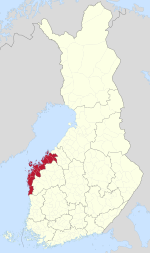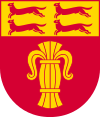Ostrobothnia (region)
Ostrobothnia
| |
|---|---|
| Region of Ostrobothnia Landskapet Österbotten Pohjanmaan maakunta | |
 Ostrobothnia on a map of Finland | |
| Country | Finland |
| Historical province | Ostrobothnia |
| Capital | Vaasa |
| Other towns | Jakobstad, Kaskinen, Kristinestad, Närpes and Nykarleby |
| Area | |
• Total | 7,932.36 km2 (3,062.70 sq mi) |
| Population (2019) | |
• Total | 180,445 |
| • Density | 23/km2 (59/sq mi) |
| GDP | |
| • Total | €6.929 billion (2015) |
| • Per capita | €38,193 (2015) |
| Time zone | UTC+2 (EET) |
| • Summer (DST) | UTC+3 (EEST) |
| ISO 3166 code | FI-12 |
| NUTS | 195 |
| Regional bird | Common swift (Apus apus) |
| Regional fish | Common whitefish (Coregonus lavaretus) |
| Regional flower | European meadowsweet (Filipendula ulmaria) |
| Website | osterbotten.fi |
Ostrobothnia (Swedish: Österbotten; Finnish: Pohjanmaa) is a region in western Finland. It borders the regions of Central Ostrobothnia, South Ostrobothnia, and Satakunta. It is one of six regions considered historical Ostrobothnia, hence it is also referred to as Coastal Ostrobothnia to avoid confusion.
Ostrobothnia is one of two Finnish regions with a Swedish-speaking majority (the other being the constitutionally monolingual province of Åland); Swedish-speakers make up 51.2% of the total population.[2] The region contains thirteen bilingual municipalities and one that is exclusively Finnish-speaking. The capital of Vaasa is predominantly inhabited by Finnish speakers, whereas smaller towns and rural areas are generally dominated by the Swedish language. The three municipalities with the largest number of Swedish speakers are Korsholm, Jakobstad and Pedersöre.
Geographically, Ostrobothnia has little topographical relief, because it is mostly former seafloor brought to surface by post-glacial rebound and the accumulation of alluvial sediment. Ostrobothnia has both vast expanses of cultivated fields (lakeus) as in Southern Ostrobothnia, and the archipelago of Kvarken (Finnish: Merenkurkku). Glacial transport has deposited large quantities of rocks in the area.[3] Like elsewhere in Ostrobothnia, rivers are a prominent part of the landscape. The major rivers that discharge into the Gulf of Bothnia in Ostrobothnia are Kyrönjoki, Lapuanjoki and Ähtävänjoki.
Kaskinen, a coastal town located in the southern part of the region, is the smallest town in Finland in terms of both area and population.[4]
Name and symbols
[edit]Prior to the officialization of the names of the Finnish regions, Ostrobothnia was also known as Vasa kustregionen in Swedish and Vaasan rannikkoseutu in Finnish, both of which translate into "[the] coastal region of Vaasa". The Institute for the Languages of Finland recommended that the region be named Kustösterbotten in Swedish and Rannikko-Pohjanmaa in Finnish, meaning "coastal Ostrobothnia" in English. However, upon the confirmation of the names of the Finnish regions on 26 February 1998, the current name of the region was officialized instead, according to the wishes of the regional government. The central government cited the Swedish language's prevalence in the region, as well as the lack of a common consensus on an alternative name the reasons for its decision.[5] In local circles or communities, Ostrobothnia is often referred to as "Pampas". The word derives from the similarities in the flat landscape with the Pampas area in South America.[6]
The regional tree is the black alder (Alnus glutinosa), the regional mammal is the common elk (Alces alces), the regional stone is Vaasa granite and the regional song is "The march of Vaasa" (Swedish: Vasamarschen, Finnish: Vaasan marssi).
Coat of arms
[edit]Gules, a sheaf Or; on chief countercharged four ermines 2+2 courant.
The sprouting wheatsheaf is a symbol of the Royal House of Vasa; a Vasa king established the city of Vaasa, the capital of the region. The running stoats are a symbol of Ostrobothnia.
Municipalities
[edit]The region of Ostrobothnia consists of 14 municipalities, 6 of which have city status (marked in bold).
Map of municipalities
[edit]Sub-regions
[edit]List of municipalities
[edit]| Coat of arms |
Municipality | Population | Land area (km2) |
Density (/km2) |
Finnish speakers |
Swedish speakers |
Other speakers |
|---|---|---|---|---|---|---|---|
 |
Jakobstad | 19,569 | 89 | 221 | 31 % | 54 % | 15 % |
 |
Kaskinen | 1,240 | 11 | 117 | 57 % | 27 % | 13 % |
 |
Korsholm | 19,744 | 849 | 23 | 28 % | 68 % | 3 % |
 |
Korsnäs | 1,989 | 236 | 8 | 4 % | 85 % | 13 % |
 |
Kristinestad | 6,128 | 683 | 9 | 41 % | 54 % | 7 % |
 |
Kronoby | 6,332 | 713 | 9 | 19 % | 76 % | 5 % |
 |
Laihia | 7,657 | 505 | 15 | 97 % | 1 % | 2 % |
 |
Larsmo | 5,881 | 143 | 41 | 5 % | 91 % | 3 % |
 |
Malax | 5,420 | 522 | 10 | 9 % | 85 % | 6 % |
 |
Närpes | 9,554 | 978 | 10 | 5 % | 75 % | 21 % |
 |
Nykarleby | 7,436 | 733 | 10 | 7 % | 84 % | 10 % |
 |
Pedersöre | 11,225 | 794 | 14 | 8 % | 88 % | 4 % |
 |
Vaasa | 70,374 | 365 | 193 | 63 % | 23 % | 12 % |
 |
Vörå | 6,209 | 782 | 8 | 12 % | 82 % | 7 % |
| Total | 178,758 | 7,403 | 24 | 40 % | 50 % | 10 % |
Language numbers
[edit]| Year | Swedish | Finnish | Russian | Other | Total | ||||
|---|---|---|---|---|---|---|---|---|---|
| Number | % | Number | % | Number | % | Number | % | ||
| 1990 | 92,827 | 55.55% | 73,648 | 44.07% | 46 | 0.03% | 587 | 0.35% | 167,108 |
| 1995 | 92,372 | 54.69% | 74,723 | 44.24% | 190 | 0.11% | 1,603 | 0.95% | 168,888 |
| 2000 | 90,778 | 54.01% | 74,780 | 44.49% | 336 | 0.20% | 2,182 | 1.30% | 168,077 |
| 2005 | 90,083 | 53.44% | 74,597 | 44.25% | 436 | 0.26% | 3,903 | 2.32% | 168,583 Figures don't add |
| 2010 | 90,375 | 52.25% | 75,542 | 43.67% | 650 | 0.38% | 6,414 | 3.71% | 172,981 |
| 2015 | 90,083 | 50.92% | 76,156 | 43.05% | 917 | 0.52% | 9,738 | 5.50% | 176,894 |
| 2020 | 89,085 | 50.67% | 73,610 | 41.87% | 975 | 0.55% | 12,146 | 6.91% | 175,816 |
Climate
[edit]Ostrobothnia is located in the borderlands between the humid continental and subarctic climates (Köppen Dfb/Dfc). Its winters are moderated by prevailing westerly winds from the mild North Atlantic Current travelling across Norway, Sweden and the Bay of Bothnia. Although the sea tends to easily freeze over in winter during prolonged spells of cold weather due to the low salinity, winters seldom get severely cold.
In general during latter decades, the southern Bothnia Bay coastlines of central Norrland in Sweden across the strait and Ostrobothnia mostly range from slightly above 20 °C (68 °F) average highs in summer to about −3 °C (27 °F) highs and −10 °C (14 °F) lows in winter. Due to the vastness of the region from north to south, this will vary by a bit from one place to another depending on latitude.
Precipitation is quite variable but is enough to build up a reliable snowpack all through the region during winter months. In summer, Ostrobothnia experiences perpetual civil twilight due to its high latitude with the sun angle never falling below -3° at summer solstice in Vaasa and -2° in Jakobstad.[8][9] During that time of the year, daylight remains bright enough to permit daytime outdoor activities without artificial lighting especially under clear skies. As a result, days are short during winter although all areas of Ostrobothnia are far south of the Arctic Circle.
See also
[edit]References
[edit]- ^ Regions and Cities > Regional Statistics > Regional Economy > Regional GDP per Capita, OECD.Stats. Accessed on 16 November 2018.
- ^ Väestö iän ja sukupuolen mukaan alueittain[permanent dead link] 31.12.2008. Tilastokeskus: demography.
- ^ "Aika, kallioperä ja jääkaudet » Merenkurkun saaristo". www.merenkurkku.fi. Retrieved 15 April 2018.
- ^ "Island town | Visit Kaskinen". visitkaskinen.fi.
- ^ "Valtioneuvosto nimesi Suomen maakunnat". The Finnish Ministry of Internal Affairs (in Finnish). 26 February 1998. Archived from the original on 24 May 2011. Retrieved 22 September 2020.
- ^ Lång, Fredrik. "Författarnas Österbotten: Pampas eller Plattlandet" (PDF) (in Swedish). KulturÖsterbotten. Retrieved December 3, 2021.
- ^ "11rl -- Language according to age and sex by region, 1990-2022". Statistics Finland. Retrieved 7 July 2023.
- ^ "Sunrise and sunset times in Vaasan Lääni, June 2021". Timeanddate.com. Retrieved 9 January 2021.
- ^ "Sunrise and sunset times in Jakobstad, June". Timeanddate.com. Retrieved 9 January 2021.
External links
[edit]![]() Media related to Ostrobothnia at Wikimedia Commons
Media related to Ostrobothnia at Wikimedia Commons



